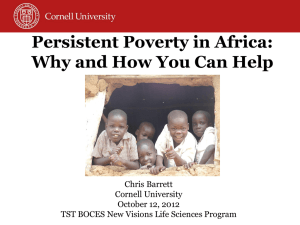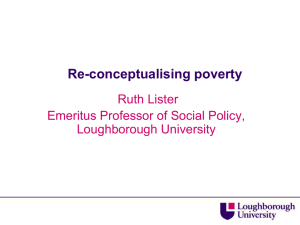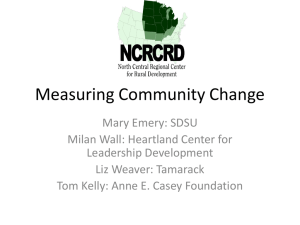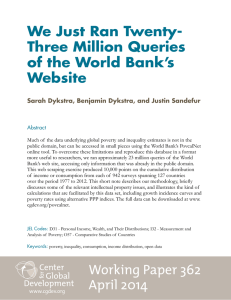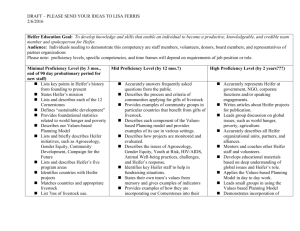Persistent Poverty in Africa: Why and How You Can Help
advertisement
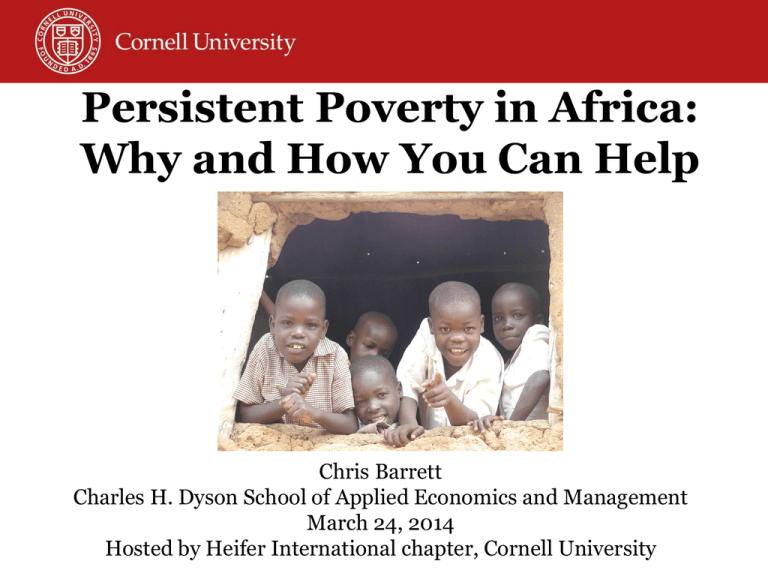
Persistent Poverty in Africa: Why and How You Can Help Chris Barrett Charles H. Dyson School of Applied Economics and Management March 24, 2014 Hosted by Heifer International chapter, Cornell University The poor are in South Asia Rapid, large-scale poverty reduction is possible … as demonstrated by a generation of rapidly falling global poverty rates, especially in East Asia. The poor are mainly in South Asia and no real progress in sub-Saharan Africa in the last 35 years. Source: World Bank, PovCalNet The ultra-poor are African The big challenge is the persistence of concentrated ultra-poverty … in Africa, where it has almost doubled in a generation. Source: World Bank, PovCalNet In 1981 Africa was home to 12% of the world’s ultra-poor … now >75%. The persistence of African ultra-poverty Longitudinal data reinforce the story Comparative Poverty Dynamics - In the US, the median - In rural Africa, we don’t know the median spell length! Most poverty is chronic, with complex and multiple causation. Ngambo, Northern Kenya 2000-2 ($0.25) 60 Percent population of population Percent of poverty spell length is only 4.5 months. The overwhelming majority of US poverty is transitory. 70 50 40 Fianarantsoa, Southern Madagascar 1997-2002 ($0.25) 30 20 Vakinankaratra, Central Madagascar 1997-2002 ($0.25) 10 United States 1993-94 ($15.05) 0 0 1 2 3 4 Continuous years in poverty Sources: USA: USA: Naifeh Naifeh (1998). (1998), Poverty others: Barrett et al. (2006 Poverty line Sources: line levels are all inJDS). inflation-adjusted levelsUS aredollars. all in inflation-adjusted 2002 US dollars. 2002 5 Becoming ultra-poor Many Are Born Poor and Stay Poor But Why Do Others Become Poor, Replacing Those Who Escape Poverty? 1) Health Shocks (malaria, HIV/AIDS, etc.) 2) Conflict/war 3) Natural Disasters (drought, flood) 4) Unemployment The public and private safety nets we take for granted rarely exist in SSA Staying ultra-poor Once Poor, Why Do People Remain Poor? - Poor early childhood health/nutrition - Limited education - Lack access to finance to invest in livestock, land, improved technologies - Underdeveloped markets - Social exclusion (race, gender, ethnicity, etc.) … all keep the poor from making enough to invest in growing richer … ‘poverty traps’ “May the odds be ever in your favor” Who has a real shot at escaping poverty? Under-five mortality rate = 18% Elem. school completion rate = 48% 14-16 yr old HIV/AIDS positive = 8% Face regular violent conflict = ~20% … Only 20-30% have a good shot at an African middle class life under current education, health and security situation .. And most face a much higher likelihood of dying a preventable, poverty-related death (cholera, typhoid, measles, childbirth …) Changing the odds How Do Some Climb/Stay Out of Poverty? - Maintain good health: avoid illness/injury - Education - Some cash to invest: savings, loans, gifts, remittances … it takes $ to make $ - Reasonable, reliable access to markets - Peace … Not much different from the US! All are scalable … we can change the odds Why should we care? Reasons: Humanitarian/ethical - Golden rule Economic - Future markets/suppliers Security/geo-political - Prospective source of insecurity Environmental - Conservation of forests, wildlife Health - Controlling pandemics How does the world help? Net aid given by governments: ~7.5 ¢ per day per person (overstated due to “tying”) Private gifts (foundations, companies and individuals): ~ 6 ¢ per day per person Develop new technologies, better institutions, smarter policies through businesses, governments, NGOs: - health care (incl. lower pricing by drug companies) - improved information/communications technologies - agricultural, water, energy, transport and other technologies (universities/research institutes) - policy research (universities/think tanks) - (good) job creation by businesses Do your donations matter? Ex: Heifer Int’l animal donation projects in Rwanda Original survey of 406 hhs in 2 locations: Ruli (Dairy cows) and Kirehe (Meat goats) Three treatment groups: Beneficiaries vs. qualified prospective beneficiaries vs. never will be beneficiaries Central findings: Dietary intake: - Households that receive a dairy cow consume 9.34 more liters of dairy per person, >3x intake of control hhs. - Families that received a donated meat goat increased monthly meat consumption by 0.20 kilograms per person, ~2x intake of controls hhs. Source: Rawlins, Pimkina, Barrett, Pedersen & Wydick (2014), “Got Milk? The Impact of Heifer International's Livestock Donation Programs in Rwanda on Nutritional Outcomes,” Food Policy 44(1): 202–213. Child (0-5 yr) nutritional status: - Meat goats: stat sig +0.5 SDs weight-for-age , +0.4 SDs weight-for-height z-score, but a only a stat insig 0.1 SD effect on height-for-age z-score. - Dairy cows: stat sig +0.5 SDs height-for-age z-score, but only a stat insig +0.4 SDs weight-for-age z-score. What can you do? 1) Recognize, be grateful for and make good use of the opportunities you have here in the US! Young Africans only dream of your opportunities. 2) Be informed and speak up to our political leaders 3) Sponsor a child, buy loved ones alternative gifts for holidays and special events. Luke 12:48: “To whom much has been given, much is expected.” Margaret Mead: “Never doubt that a small group of thoughtful, committed citizens can change the world; indeed, it's the only thing that ever has.” “Most of the people in the world are poor, so if we knew the economics of being poor we would know much of the economics that really matters. Most of the world’s poor people earn their living from agriculture, so if we knew the economics of agriculture we would know much of the economics of being poor.” - Theodore W. Schultz Opening sentences of 1979 Nobel Prize in Economics lecture Africa is the world’s most agrarian/rural continent. CALS majors have uncommon capacity to help! If you had been born to a poor woman in rural Africa, what would you want others to do for you? Thanks for your interest!
